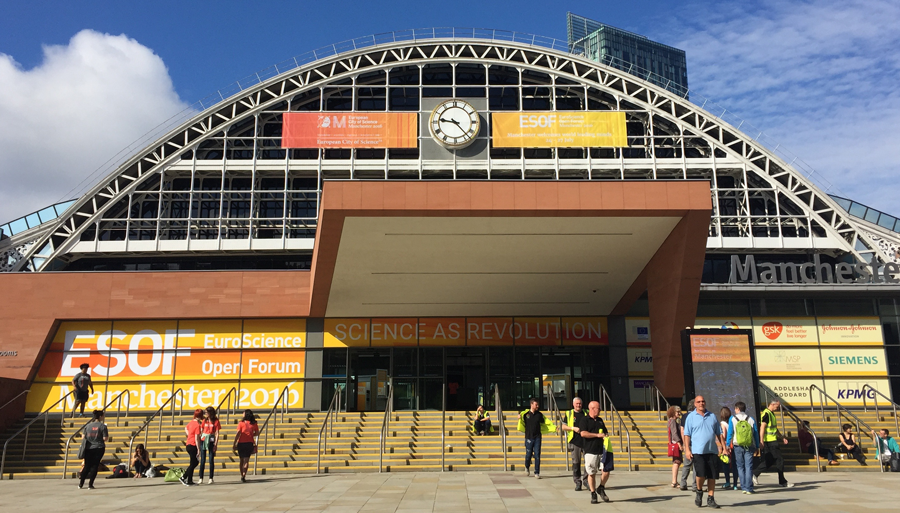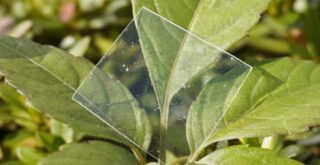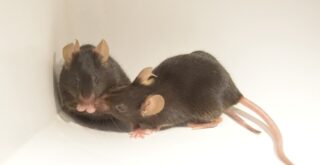It’s been a week since we got back from attending the EuroScience Open Forum (ESOF) in Manchester. It was a great conference and experience, and I thought it would be nice to write a few posts detailing what it was like and what I got out of it.
The day before the actual ESOF conference, we attended the 3rd European Conference of Science Journalists. The opening panel discussion ([itg-tooltip tooltip-content=”<h3 style=&aquot;box-sizing: border-box; margin: 10px 0px; font-family: Lato, Verdana, Geneva, sans-serif; font-weight: 400; line-height: 1.2; color: #cc0000; text-rendering: optimizeLegibility; font-size: 1.3em;&aquot;>Highway robbery: Is Europe’s independent science news being hijacked by vested interests?</h3><br/><p style=&aquot;box-sizing: border-box; margin: 10px 0px; color: #666666; padding: 0px; font-family: Lato, Verdana, Geneva, sans-serif; font-size: 14px; line-height: 20px;&aquot;>A recent trend across Europe is for science news to be provided by quasi-independent media, funded more or less directly by governments/scientific foundations about whose research they report. They are written/edited by journalists and packaged as journalism but they are not truly independent. In addition, commercial or vested interests are commissioning research with the primary aim of gaining media coverage that is favourable to their interests or products. Is independent science news in Europe being hijacked by these developments or are they providing new perspectives for the public?</p><br/><p style=&aquot;box-sizing: border-box; margin: 10px 0px; color: #666666; padding: 0px; font-family: Lato, Verdana, Geneva, sans-serif; font-size: 14px; line-height: 20px;&aquot;>Chair: Deborah Cohen, Editor BBC Radio Science Unit, UK</p><br/><p style=&aquot;box-sizing: border-box; margin: 10px 0px; color: #666666; padding: 0px; font-family: Lato, Verdana, Geneva, sans-serif; font-size: 14px; line-height: 20px;&aquot;>Panellists: Pampa G Molina, Slobodan Bubnjevic, Ivana Horvat, Jane Gregory, David Miller</p>”]details here[/itg-tooltip]) was pretty interesting, and focussed on issues that develop when science news is produced by people working for institutions. Speak of the devil, that’s my job! In the end, the panel and the audience recognized the legitimacy this type of work (phew!), but stressed the need for total openness and full disclosures, especially regarding funding. I think most agreed that disclosing conflicts of interest is crucial, and that these details are often left out when the information does not come from an independent source. Actually, to me this means that investigative journalism still has a big role to play in science communication.
After lunch I attended two sessions about making podcasts ([itg-tooltip tooltip-content=”<h3 id=&aquot;aeaoofnhgocdbnbeljkmbjdmhbcokfdb-mousedown&aquot; style=&aquot;box-sizing: border-box; margin: 10px 0px; font-family: Lato, Verdana, Geneva, sans-serif; font-weight: 400; line-height: 1.2; color: #cc0000; text-rendering: optimizeLegibility; font-size: 1.3em;&aquot;>How to move into broadcasting & podcasting</h3><br/><p style=&aquot;box-sizing: border-box; margin: 10px 0px; color: #666666; padding: 0px; font-family: Lato, Verdana, Geneva, sans-serif; font-size: 14px; line-height: 20px;&aquot;>A two hour training session, where you will learn the basics of audio journalism. Tips and tricks regarding field recording. Audio editing basics, using the Hindenburg Broadcaster. How to publish using the EBU loudness regulations for Broadcast and Podcast. </p><br/><p style=&aquot;box-sizing: border-box; margin: 10px 0px; color: #666666; padding: 0px; font-family: Lato, Verdana, Geneva, sans-serif; font-size: 14px; line-height: 20px;&aquot;>Mr. Nick Dunkerley<br style=&aquot;box-sizing: border-box;&aquot; />Creative Director, Founder, <a style=&aquot;box-sizing: border-box; color: #f0525b; text-decoration: none; cursor: pointer; outline: none;&aquot; href=&aquot;http://hindenburg.com/about&aquot; rel=&aquot;alternate&aquot;>Hindenburg Systems</a></p>”]details here[/itg-tooltip]) that were really informative, and it made me wish I had the time to start a podcast for It Ain’t Magic. Nick Dunkerley from Denmark was a truly gifted sound person and speaker about sound. He mixed and edited clips on the fly while talking, fixing his powerpoint slides, and playing excerpts from amazing podcasts that used the techniques he described. One of the best clips he played was from this episode of Radiolab.
And now I’m hooked. Not only did I learn a lot about how to make a good podcast (from the best type of microphone and interview techniques to mixing in ambient sounds and the importance of recoding as many of those sounds yourself), but I learned about some great podcasts that are already out there, like Radiolab. I think sometimes we forget how good audio can be even without any video.
Next I chose to go to the session called “Perfect Pitch”. Four aspiring science journalists pitched their ideas live to a panel of editors. In addition to being fun (for the audience), this was good insight into the decision process that magazines and newspapers (print and online) go through when deciding whether a freelance journalist has a good story or not. Some take-away messages were to keep in mind who the readership is and the timelines of the article (why is this topic good right now?). Also, framing your facts with a story (and being sure to interview people) really helps to grab interest.
The [itg-tooltip tooltip-content=”<h3 id=&aquot;aeaoofnhgocdbnbeljkmbjdmhbcokfdb-mousedown&aquot; style=&aquot;box-sizing: border-box; margin: 10px 0px; font-family: Lato, Verdana, Geneva, sans-serif; font-weight: 400; line-height: 1.2; color: #cc0000; text-rendering: optimizeLegibility; font-size: 1.3em;&aquot;>Outside the consensus – working for media that are ‘sceptical’ about climate change</h3><br/><p style=&aquot;box-sizing: border-box; margin: 10px 0px; color: #666666; padding: 0px; font-family: Lato, Verdana, Geneva, sans-serif; font-size: 14px; line-height: 20px;&aquot;>There is an extremely strong consensus between scientists in Europe and across the world that climate change is happening, is driven by man, and poses serious risks if it is not tackled. Yet in most European countries there are one or more newspapers or broadcast organisations that have an editorial line that is ‘sceptical’ of scientific consensus. Science writers and journalists for such organisations can be expected to report both the findings and views of the consensus scientific community, and of those individuals and organisations that reject the consensus. How should journalists and science writers manage such a task in a way that both satisfies their editors and promotes the public interest?</p><br/><p style=&aquot;box-sizing: border-box; margin: 10px 0px; color: #666666; padding: 0px; font-family: Lato, Verdana, Geneva, sans-serif; font-size: 14px; line-height: 20px;&aquot;>Chair: Steve Connor, former science editor The Independent, UK</p><br/><p style=&aquot;box-sizing: border-box; margin: 10px 0px; color: #666666; padding: 0px; font-family: Lato, Verdana, Geneva, sans-serif; font-size: 14px; line-height: 20px;&aquot;>Panellists: Geoffrey Lean, Tim Radford, Viola Egikova, Louise Gray, Ben Jackson</p>”]closing session[/itg-tooltip] was a panel discussion about being a science journalist who works for media that are skeptical about climate change. This was a little scary, but the frank discussion by the panel really showed how tough it is to be a journalist. So the message I got was that you may have passionate ideas and an interest in science (dare I say ‘facts’), but at the end of the day, unless you own a newspaper, you work at the whim of the publisher. I think the frustration of the some of the people on the panel really came through.
At night we went to the 2016 [itg-tooltip tooltip-content=”<p><strong>ABSW:</strong> Association of British Science Writers</p>”]ABSW[/itg-tooltip] Science Writers Awards ceremony at the Bluedot music festival at Jodrell Bank Observatory outside Manchester. There were tons of people, camping tents, science, port-a-potties, wet grass, art, technology, food, culture, and music. The observatory is out in the fields. Total farmland. Loads of sheep. And suddenly a gimungous telescope. The award ceremony was nice, albeit hard to hear over the noise of people talking, drinking, and eating appetizers. All in all, this satellite conference was a good start to ESOF, which I’ll write more about next week. ◼︎
It’s been a week since we got back from attending the EuroScience Open Forum (ESOF) in Manchester. It was a great conference and experience, and I thought it would be nice to write a few posts detailing what it was like and what I got out of it.
The day before the actual ESOF conference, we attended the 3rd European Conference of Science Journalists. The opening panel discussion ([itg-tooltip tooltip-content=”<h3 style=&aquot;box-sizing: border-box; margin: 10px 0px; font-family: Lato, Verdana, Geneva, sans-serif; font-weight: 400; line-height: 1.2; color: #cc0000; text-rendering: optimizeLegibility; font-size: 1.3em;&aquot;>Highway robbery: Is Europe’s independent science news being hijacked by vested interests?</h3><br/><p style=&aquot;box-sizing: border-box; margin: 10px 0px; color: #666666; padding: 0px; font-family: Lato, Verdana, Geneva, sans-serif; font-size: 14px; line-height: 20px;&aquot;>A recent trend across Europe is for science news to be provided by quasi-independent media, funded more or less directly by governments/scientific foundations about whose research they report. They are written/edited by journalists and packaged as journalism but they are not truly independent. In addition, commercial or vested interests are commissioning research with the primary aim of gaining media coverage that is favourable to their interests or products. Is independent science news in Europe being hijacked by these developments or are they providing new perspectives for the public?</p><br/><p style=&aquot;box-sizing: border-box; margin: 10px 0px; color: #666666; padding: 0px; font-family: Lato, Verdana, Geneva, sans-serif; font-size: 14px; line-height: 20px;&aquot;>Chair: Deborah Cohen, Editor BBC Radio Science Unit, UK</p><br/><p style=&aquot;box-sizing: border-box; margin: 10px 0px; color: #666666; padding: 0px; font-family: Lato, Verdana, Geneva, sans-serif; font-size: 14px; line-height: 20px;&aquot;>Panellists: Pampa G Molina, Slobodan Bubnjevic, Ivana Horvat, Jane Gregory, David Miller</p>”]details here[/itg-tooltip]) was pretty interesting, and focussed on issues that develop when science news is produced by people working for institutions. Speak of the devil, that’s my job! In the end, the panel and the audience recognized the legitimacy this type of work (phew!), but stressed the need for total openness and full disclosures, especially regarding funding. I think most agreed that disclosing conflicts of interest is crucial, and that these details are often left out when the information does not come from an independent source. Actually, to me this means that investigative journalism still has a big role to play in science communication.
After lunch I attended two sessions about making podcasts ([itg-tooltip tooltip-content=”<h3 id=&aquot;aeaoofnhgocdbnbeljkmbjdmhbcokfdb-mousedown&aquot; style=&aquot;box-sizing: border-box; margin: 10px 0px; font-family: Lato, Verdana, Geneva, sans-serif; font-weight: 400; line-height: 1.2; color: #cc0000; text-rendering: optimizeLegibility; font-size: 1.3em;&aquot;>How to move into broadcasting & podcasting</h3><br/><p style=&aquot;box-sizing: border-box; margin: 10px 0px; color: #666666; padding: 0px; font-family: Lato, Verdana, Geneva, sans-serif; font-size: 14px; line-height: 20px;&aquot;>A two hour training session, where you will learn the basics of audio journalism. Tips and tricks regarding field recording. Audio editing basics, using the Hindenburg Broadcaster. How to publish using the EBU loudness regulations for Broadcast and Podcast. </p><br/><p style=&aquot;box-sizing: border-box; margin: 10px 0px; color: #666666; padding: 0px; font-family: Lato, Verdana, Geneva, sans-serif; font-size: 14px; line-height: 20px;&aquot;>Mr. Nick Dunkerley<br style=&aquot;box-sizing: border-box;&aquot; />Creative Director, Founder, <a style=&aquot;box-sizing: border-box; color: #f0525b; text-decoration: none; cursor: pointer; outline: none;&aquot; href=&aquot;http://hindenburg.com/about&aquot; rel=&aquot;alternate&aquot;>Hindenburg Systems</a></p>”]details here[/itg-tooltip]) that were really informative, and it made me wish I had the time to start a podcast for It Ain’t Magic. Nick Dunkerley from Denmark was a truly gifted sound person and speaker about sound. He mixed and edited clips on the fly while talking, fixing his powerpoint slides, and playing excerpts from amazing podcasts that used the techniques he described. One of the best clips he played was from this episode of Radiolab.
And now I’m hooked. Not only did I learn a lot about how to make a good podcast (from the best type of microphone and interview techniques to mixing in ambient sounds and the importance of recoding as many of those sounds yourself), but I learned about some great podcasts that are already out there, like Radiolab. I think sometimes we forget how good audio can be even without any video.
Next I chose to go to the session called “Perfect Pitch”. Four aspiring science journalists pitched their ideas live to a panel of editors. In addition to being fun (for the audience), this was good insight into the decision process that magazines and newspapers (print and online) go through when deciding whether a freelance journalist has a good story or not. Some take-away messages were to keep in mind who the readership is and the timelines of the article (why is this topic good right now?). Also, framing your facts with a story (and being sure to interview people) really helps to grab interest.
The [itg-tooltip tooltip-content=”<h3 id=&aquot;aeaoofnhgocdbnbeljkmbjdmhbcokfdb-mousedown&aquot; style=&aquot;box-sizing: border-box; margin: 10px 0px; font-family: Lato, Verdana, Geneva, sans-serif; font-weight: 400; line-height: 1.2; color: #cc0000; text-rendering: optimizeLegibility; font-size: 1.3em;&aquot;>Outside the consensus – working for media that are ‘sceptical’ about climate change</h3><br/><p style=&aquot;box-sizing: border-box; margin: 10px 0px; color: #666666; padding: 0px; font-family: Lato, Verdana, Geneva, sans-serif; font-size: 14px; line-height: 20px;&aquot;>There is an extremely strong consensus between scientists in Europe and across the world that climate change is happening, is driven by man, and poses serious risks if it is not tackled. Yet in most European countries there are one or more newspapers or broadcast organisations that have an editorial line that is ‘sceptical’ of scientific consensus. Science writers and journalists for such organisations can be expected to report both the findings and views of the consensus scientific community, and of those individuals and organisations that reject the consensus. How should journalists and science writers manage such a task in a way that both satisfies their editors and promotes the public interest?</p><br/><p style=&aquot;box-sizing: border-box; margin: 10px 0px; color: #666666; padding: 0px; font-family: Lato, Verdana, Geneva, sans-serif; font-size: 14px; line-height: 20px;&aquot;>Chair: Steve Connor, former science editor The Independent, UK</p><br/><p style=&aquot;box-sizing: border-box; margin: 10px 0px; color: #666666; padding: 0px; font-family: Lato, Verdana, Geneva, sans-serif; font-size: 14px; line-height: 20px;&aquot;>Panellists: Geoffrey Lean, Tim Radford, Viola Egikova, Louise Gray, Ben Jackson</p>”]closing session[/itg-tooltip] was a panel discussion about being a science journalist who works for media that are skeptical about climate change. This was a little scary, but the frank discussion by the panel really showed how tough it is to be a journalist. So the message I got was that you may have passionate ideas and an interest in science (dare I say ‘facts’), but at the end of the day, unless you own a newspaper, you work at the whim of the publisher. I think the frustration of the some of the people on the panel really came through.
At night we went to the 2016 [itg-tooltip tooltip-content=”<p><strong>ABSW:</strong> Association of British Science Writers</p>”]ABSW[/itg-tooltip] Science Writers Awards ceremony at the Bluedot music festival at Jodrell Bank Observatory outside Manchester. There were tons of people, camping tents, science, port-a-potties, wet grass, art, technology, food, culture, and music. The observatory is out in the fields. Total farmland. Loads of sheep. And suddenly a gimungous telescope. The award ceremony was nice, albeit hard to hear over the noise of people talking, drinking, and eating appetizers. All in all, this satellite conference was a good start to ESOF, which I’ll write more about next week. ◼︎







